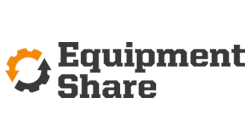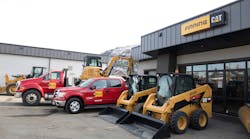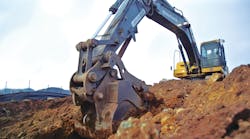Revenue grew 13 percent year over year in the fourth quarter of 2021 according to respondents to the Baird/RER Q4 equipment rental survey, while respondents expect a 9.5-percent growth clip in 2022. Most key end markets are expected to provide solid demand tailwinds in 2022. However, there are industry dynamics that will likely impede growth such as labor shortages and equipment availability. These issues will make it increasingly difficult to capitalize on what should be a robust environment.
Fifty-six percent of respondents on a revenue-weighted basis said revenue and utilization were higher than what they originally budgeted for in the fourth quarter, while 42 percent said business was in line with expectations.
Rental rates were up 2.7 percent year over year – similar to last quarter. However, utilization was 600 basis points lower year over year. Rental companies faced multiple headwinds that continue to impact demand growth including labor shortages, which was challenging for rental companies as well as customers, and long lead times for new equipment.
Most respondents experienced improving end-market demand as activity returned closer to normal levels. Average rental revenue jumped 12.8 percent year over year, an improvement compared to third quarter growth (10.2 percent), while fourth quarter of 2020 revenue had declined 1.5 percent. Average rental rates were up 2.7 percent year over year, but flat with the third quarter, which was the best growth since the first quarter of 2018 as the industry rebounded from the COVID-induced low of 2020. Improvement in rental demand and improved utilization provided flexibility in pricing.
Growth in the cost of new units increased 6.8 percent, a slightly higher increase than the third quarter had, which was the highest growth in this area since the first quarter of 2013. Baird experts said higher equipment prices were not only the result of rising input costs for steel, freight and labor, but a function of improved PEM pricing power.
Fleet utilization of 60.4 percent was down about 600 basis points from the third quarter, which was a survey high, and down about 300 basis points year over year compared to last year. Utilization was down year over year for the first time in 2021.
Rental Revenue to Grow 7 Percent in Q1
Respondents expect rental revenue to grow 7 percent year over year in the first quarter of 2022, which is below their actual growth in the fourth quarter. Respondents expect fleet spending to increase 7.6 percent over the next six months. They expect to increase spending on access equipment by about 4.9 percent, with earthmoving equipment spending expected to increase 7.7 percent.
The labor shortage has led to higher wages, impacting rental rates and margins, and lost business for rental companies and their customers. Thirty-nine percent of respondents have raised rental rates to offset higher wages, and 48 percent are seeing an impact to the bottom line as a result of higher wages. Thirty-seven percent say they do not have enough workers to effectively run their business. Forty-three percent of respondents say they believe business is being lost because customers don’t have enough labor.
Average rental revenue increased 12.8 percent year over year in the fourth quarter. Revenue only declined 1.5 percent in the fourth quarter as Covid restrictions ease, meaning revenue was above pre-Covid levels for the second consecutive quarter.
“Tremendous supply chain issues continue to not only impact new deliveries but also repair parts, negatively impacting our parts and service business,” said one respondent. “Inflationary prices for fuel, freight, supplies, wages – all significantly creating havoc in navigating our business and trying to provide consistent customer service.”
“Supply chain issues remain a concern, contractors are getting squeezed by material cost,” added another. “Although I feel it is a net positive because they won’t be able to afford to buy the machines so they will end up renting from us.”
The utilization rate for access equipment fell to 62.6 percent from 65.1 percent in the fourth quarter of 2020, while the utilization rate for earthmoving equipment fell to 62.8 percent compared to 67.6 percent in the fourth quarter. Small iron utilization dropped from 54.3 percent a year ago to 51.7 percent in the fourth quarter of 2021.
Rental Rates to Jump 3.9 Percent in 2022
Respondents expect rental rates to increase 3.9 percent in 2022, even better than the first quarter increase. The shortage of larger rental equipment will help drive up rental rates, respondents said. Respondents expect a 7 percent revenue hike in the first quarter, with 41 percent expecting a 5 to 10 percent revenue jump and 35 percent expecting a 1 to 5 percent increase. For the full year, respondents expect a 9.5 percent hike.
Industrial and nonresidential construction end markets have the most positive outlooks for 2022. Ninety-seven percent of respondents expect the industrial/manufacturing/chemicals end market to remain healthy or improve in 2022, 95 percent view nonresidential construction favorably, and 89 percent are favorable toward municipal/government. Eighty percent view the residential end market favorably, with oil and gas and energy at 68 percent; infrastructure and pipelines at 67 percent and consumer/homeowner at 58 percent.
The cost of new units increased 6.8 percent, up slightly from the previous quarter (6.3 percent). OEMs are apparently increasing equipment pricing to offset cost inflation, including record high steel prices. The continuing extension of lead times for equipment is a consistent theme among survey respondents.
Average fleet size in units jumped 4.6 percent year over year in the fourth quarter, the strongest growth since the first quarter of 2019, while respondents expect fleet purchases to be up 7.6 percent for the next six months, with access spending up 4.9 percent, earthmoving 7.7 percent, small iron 8 percent and other 13.4 percent.
Purchases would likely be higher if more equipment was available. 58 percent reported lead times getting much worse, especially for smaller players, and 74 percent report earthmoving equipment availability has gotten worse the past several months.
Thirty-seven percent of respondents report a negative impact on their business from not having enough workers, and 43 percent see a negative impact on their customers, forcing them sometimes to pass up projects.
Respondents noted that Covid is contributing to staffing being sometimes from 50 to 75 percent of full capacity, thus exacerbating labor shortages.








